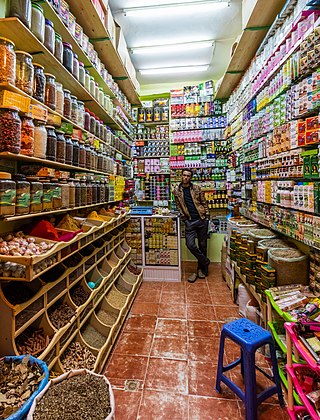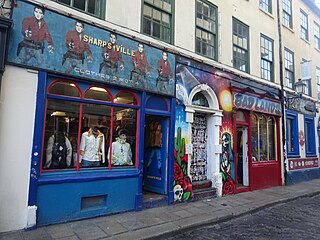
Mid-luxury is a term applied in the U.S. market to fashion, vehicles, hotels, apartments, and other consumer goods and services, for brands that are not as expensive as luxury goods, but more expensive than mass market brands.

Mid-luxury is a term applied in the U.S. market to fashion, vehicles, hotels, apartments, and other consumer goods and services, for brands that are not as expensive as luxury goods, but more expensive than mass market brands.
Fashion brands identified as mid-luxury in the U.S. market include Brooks Brothers, Coach, Hugo Boss, Lacoste, Tommy Hilfiger, and Ralph Lauren. Indochino is a manufacturer, selling mid-luxury custom-made business shirts direct to consumers. [1] [2]
As of 2018, Amazon U.S. has been struggling to get luxury brands to sell on its platform, but has had success with selling its house brands, such as Pinzon (sheets and other domestics) targeted at the mid-luxury market.
"Mid-luxury" is a term equivalent to mid-size luxury cars. [3] [4] [5]

Shopping is an activity in which a customer browses the available goods or services presented by one or more retailers with the potential intent to purchase a suitable selection of them. A typology of shopper types has been developed by scholars which identifies one group of shoppers as recreational shoppers, that is, those who enjoy shopping and view it as a leisure activity.

Retail is the sale of goods and services to consumers, in contrast to wholesaling, which is sale to business or institutional customers. A retailer purchases goods in large quantities from manufacturers, directly or through a wholesaler, and then sells in smaller quantities to consumers for a profit. Retailers are the final link in the supply chain from producers to consumers.

In sociology and in economics, the term conspicuous consumption describes and explains the consumer practice of buying and using goods of a higher quality, price, or in greater quantity than practical. In 1899, the sociologist Thorstein Veblen coined the term conspicuous consumption to explain the spending of money on and the acquiring of luxury commodities specifically as a public display of economic power—the income and the accumulated wealth—of the buyer. To the conspicuous consumer, the public display of discretionary income is an economic means of either attaining or of maintaining a given social status.

A luxury car is a car that provides above-average to high-end levels of comfort, features, and equipment. Often more expensive materials and surface finishes are used, and buyers expect better build quality. The usually higher pricing and more upscale appearance is often associated with higher social status of the users, compared to low and mid-market segment cars.

In economics, a luxury good is a good for which demand increases more than what is proportional as income rises, so that expenditures on the good become a greater proportion of overall spending. Luxury goods are in contrast to necessity goods, where demand increases proportionally less than income. Luxury goods is often used synonymously with superior goods.

Full-size car—also known as large car—is a vehicle size class which originated in the United States and is used for cars larger than mid-size cars. It is the largest size class for cars. In Europe, it is known as E-segment or F-segment.

Thrift store chic refers to a style of dressing where clothes are cheap and/or used. Clothes are often bought from thrift stores such as the Salvation Army, Goodwill, or Value Village. Originally popular among the hippies of the late 1960s, this fashion movement resurfaced during the mid-1980s among teenagers, and expanded into the 1990s with the growing popularity of such music and style influences including the grunge band Nirvana. Thrift store chic can be considered as an anti-fashion statement because it does not follow fashion trends and does not attempt to look expensive or new.
Streetwear is a style of casual clothing which became global in the 1990s. It grew from New York hip hop fashion and Californian surf culture to encompass elements of sportswear, punk, skateboarding, 1980s nostalgia, and Japanese street fashion. Later, haute couture became an influence, and was in turn influenced by streetwear. Streetwear centers on comfortable clothing and accessories such as jeans, T-shirts, baseball caps, and sneakers. Brands may create exclusivity through intentional product scarcity; enthusiasts follow particular brands and try to obtain limited edition releases, including via proxy purchases.
Masstige is a marketing term meaning downward brand extension. The word is a portmanteau of the words mass and prestige and has been described as "prestige for the masses".

Coty Inc. is an American multinational beauty company founded in 1904 by François Coty. With its subsidiaries, it develops, manufactures, markets, and distributes fragrances, cosmetics, skin care, nail care, and both professional and retail hair care products. Coty owns around 77 brands as of 2018.

Vintage clothing is a generic term for garments originating from a previous era, as recent as the 1990s. The term can also be applied in reference to second-hand retail outlets, e.g. in vintage clothing store. While the concept originated during World War I as a response to textile shortages, vintage dressing encompasses choosing accessories, mixing vintage garments with new, as well as creating an ensemble of various styles and periods. Vintage clothes typically sell at low prices for high-end name brands.

Arc'teryx is a Canadian high-end design company specializing in outdoor apparel and equipment headquartered in North Vancouver, British Columbia. It focuses on technical apparel for mountaineering and Alpine sports, including related accessories. The company's name and logo reference the Archaeopteryx, the transitional fossil of early dinosaurs to modern dinosaurs (birds). Arc'teryx is known for its waterproof Gore-Tex shell jackets, knitwear, and down parkas.

Fast fashion is the business model of replicating recent catwalk trends and high-fashion designs, mass-producing them at a low cost, and bringing them to retail quickly while demand is at its highest. The term fast fashion is also used generically to describe the products of this business model. Retailers who employ the fast fashion strategy include Primark, H&M, Shein, and Zara, all of which have become large multinationals by driving high turnover of inexpensive seasonal and trendy clothing that appeals to fashion-conscious consumers.
The term "mass market" refers to a market for goods produced on a large scale for a significant number of end consumers. The mass market differs from the niche market in that the former focuses on consumers with a wide variety of backgrounds with no identifiable preferences and expectations in a large market segment. Traditionally, businesses reach out to the mass market with advertising messages through a variety of media including radio, TV, newspapers and the Web.
Premium pricing is the practice of keeping the price of one of the products or service artificially high in order to encourage favorable perceptions among buyers, based solely on the price. Premium refers to a segment of a company's brands, products, or services that carry tangible or imaginary surplus value in the upper mid- to high price range. The practice is intended to exploit the tendency for buyers to assume that expensive items enjoy an exceptional reputation or represent exceptional quality and distinction. A premium pricing strategy involves setting the price of a product higher than similar products. This strategy is sometimes also called skim pricing because it is an attempt to “skim the cream” off the top of the market. It is used to maximize profit in areas where customers are happy to pay more, where there are no substitutes for the product, where there are barriers to entering the market or when the seller cannot save on costs by producing at a high volume.
Counterfeit consumer goods—or counterfeit, fraudulent, and suspect items (CFSI)—are goods, often of inferior quality, made or sold under another's brand name without the brand owner's authorization. The colloquial terms knockoff or dupe (duplicate) are often used interchangeably with counterfeit, although their legal meanings are not identical.

Luxury and specialty packaging is the design, research, development, and manufacturing of packaging, displays, and for luxury brands. The packaging of a luxury product is part of the brand’s image and research shows consumers are willing to spend more on products if the packaging looks appealing and luxurious.
Hype in marketing is a strategy of using extreme publicity. Hype as a modern marketing strategy is closely associated with social media.
The term "fashion brand" includes all the brands that operate within the fashion industry. A fashion brand combines symbolism, style, and experiential elements, and it needs to differentiate its products and coordinate its supply chain to succeed in the market. Consumers commonly employ brands as a means of expressing either their genuine identity or an idealized self-image that they aspire to achieve.